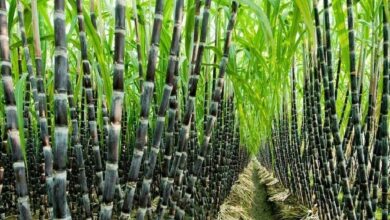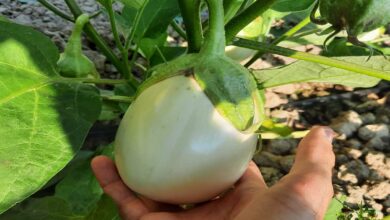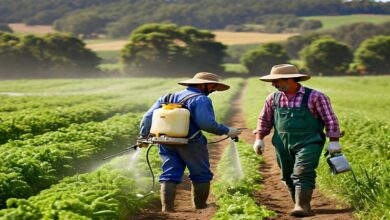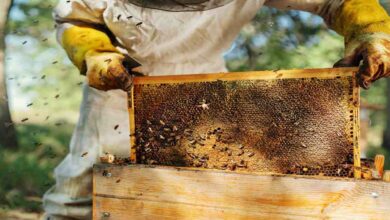Banana Farming: While using fertilizer in banana crop, keep these 6 things in mind
Banana Farming: In place of conventional farming, the majority of the nation’s farmers engage in non-traditional farming. The majority of farmers choose to grow bananas in order to make a lot of money quickly. In North India, particularly in Uttar Pradesh and Bihar, the banana crop is regarded as quite significant. Using the right fertilizer is crucial for farmers to achieve the highest possible banana crop growth, output, and fruit quality. Banana fertilizer systems in North India should be designed with the crop’s development phases, local soil, and climate in mind.
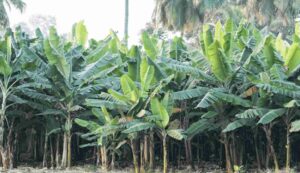
1. The stage before planting
It is crucial to prepare the soil with organic matter and basic fertilizers before planting.
During field preparation, incorporate 40–50 tons of well-decomposed farmyard manure (FYM) per hectare into the soil.
Apply lime at least two to three months before planting if the pH of the soil is less than 6.5, as determined by the results of the soil test. Apply green manure to the field 50 days before banana planting, if time permits.
2. Stage of planting
When planting, fill the planting hole with a blend of fertilizers:
Well-decomposed FYM, 5 kilogram
250 grams of neem cake (used as a natural insect deterrent and fertilizer)
20 g of carbofuran (to combat nematodes)
200 g of superphosphate alone
50 g of potash muriate
Before planting the suckers, combine these ingredients with the pit’s topsoil.
3. Phase of vegetative development (one to three months after planting)
In order to encourage leaf establishment and development, concentrate on applying nitrogen at this stage.
At 30 and 60 days following planting, apply 100 g of urea per plant in two equal doses.
After 60 days of sowing, apply 50 g of muriate of potash per plant.
4. The first stage of reproduction (4-6 months after planting)
A balanced diet becomes crucial when the plant gets ready to bloom:
At 90 and 120 days following planting, apply 150 g of urea per plant in two equal doses.
After 120 days after sowing, give each plant 100 g of muriate potash.
During this stage, foliar application of micronutrients is advantageous, particularly boron (0.1%) and zinc sulphate (5%) in particular.
5. The stage of bunch development and flowering (seven to nine months after planting)
The need for nutrition rises dramatically during this phase.
At 150 and 180 days following planting, apply 200 g of urea per plant in two equal doses.
180 days after planting, give each plant 150 g of muriate of potash.
Fruit quality and fullness may be enhanced by using a 1% potassium nitrate foliar spray.
6. The stage of fruit growth and maturity (10–12 months after planting)
Pay attention to potassium spray to increase fruit output and quality.
210 days after planting, give each plant 100 g of urea.
At 210 and 240 days after planting, apply 200 g of muriate of potash per plant in two equal doses.
Fruit size and quality are increased by foliar spraying 1% sulfate of potash.
Other Things to Think About
Testing of Soils
To modify fertilizer recommendations depending on soil nutrient status, do routine soil testing (at least once a year).
Watering
To promote nutrient absorption and prevent fertilizer burn, make sure you are well irrigated, particularly when using fertilizer.
Natural Substances
Use organic materials all the way through the crop cycle. Every three to four months, add 5 kg of vermicompost or well-decomposed FYM per plant.
Nutrition in Foliar Form
Consider spraying a balanced micronutrient mix (including Fe, Mn, Zn, Cu, and B) at a 0.5% dosage every two to three months in addition to the foliar sprays already indicated.
Fertigation
For more effective fertilizer delivery, think about fertigation if drip watering is an option. Apply using the drip method after dividing the whole amount of fertilizer needed into weekly doses.
Control of pH
For the best nutrient availability, keep the pH of your soil between 6.5 and 7.5 by routinely checking it and adding gypsum or lime as necessary.
Crops for Ratoons
Use a similar fertilizer regimen for ratoon crops, but because of their established root system and great output potential, raise the dosage by 25 to 30%.
Climate Factors
Adapt the timing of fertilizer applications in north India to the monsoon season. To stop nutrient leaching, do not use fertilizers during times of high rainfall.
Biofertilizers
Use biofertilizers like phosphate-solubilizing bacteria and Azospirillum to improve soil health and nutrient uptake. Each plant should get 50 g of each biofertilizer when it is first planted and then every three months after that.
Green manure
To increase the soil’s organic matter and nutritional status, try to plant green manure crops like sunnhemp or dhaincha in between banana rows and add them to the soil before it blooms.
Growers of bananas in North India may maximize crop nutrition management by applying fertilizer in phases and taking other aspects into account. By ensuring that plants get enough nutrients throughout their development cycle, this method improves fruit quality, yields, and plant health. It is crucial to remember that these suggestions should be appropriately modified in light of regional circumstances, cultivation needs, and the outcomes of regular analyses of soil and plant tissue.


